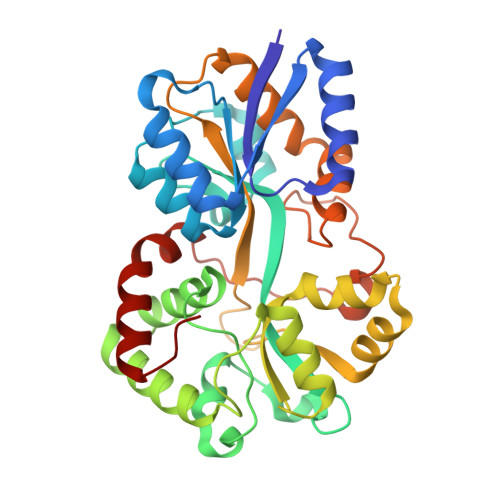Structural and functional characterization of IdiA/FutA (Tery_3377), an iron-binding protein from the ocean diazotrophTrichodesmium erythraeum.
Polyviou, D., Machelett, M.M., Hitchcock, A., Baylay, A.J., MacMillan, F., Moore, C.M., Bibby, T.S., Tews, I.(2018) J Biological Chem 293: 18099-18109
- PubMed: 30217820
- DOI: https://doi.org/10.1074/jbc.RA118.001929
- Primary Citation of Related Structures:
6G7N, 6G7P, 6G7Q - PubMed Abstract:
Atmospheric nitrogen fixation by photosynthetic cyanobacteria (diazotrophs) strongly influences oceanic primary production and in turn affects global biogeochemical cycles. Species of the genus Trichodesmium are major contributors to marine diazotrophy, accounting for a significant proportion of the fixed nitrogen in tropical and subtropical oceans. However, Trichodesmium spp. are metabolically constrained by the availability of iron, an essential element for both the photosynthetic apparatus and the nitrogenase enzyme. Survival strategies in low-iron environments are typically poorly characterized at the molecular level, because these bacteria are recalcitrant to genetic manipulation. Here, we studied a homolog of the iron deficiency-induced A (IdiA)/ferric uptake transporter A (FutA) protein, Tery_3377, which has been used as an in situ iron-stress biomarker. IdiA/FutA has an ambiguous function in cyanobacteria, with its homologs hypothesized to be involved in distinct processes depending on their cellular localization. Using signal sequence fusions to GFP and heterologous expression in the model cyanobacterium Synechocystis sp. PCC 6803, we show that Tery_3377 is targeted to the periplasm by the twin-arginine translocase and can complement the deletion of the native Synechocystis ferric-iron ABC transporter periplasmic binding protein (FutA2). EPR spectroscopy revealed that purified recombinant Tery_3377 has specificity for iron in the Fe 3+ state, and an X-ray crystallography-determined structure uncovered a functional iron substrate-binding domain, with Fe 3+ pentacoordinated by protein and buffer ligands. Our results support assignment of Tery_3377 as a functional FutA subunit of an Fe 3+ ABC transporter but do not rule out dual IdiA function.
- From the Ocean and Earth Sciences, National Oceanography Centre Southampton, University of Southampton, Southampton SO14 3ZH, United Kingdom.
Organizational Affiliation:



















